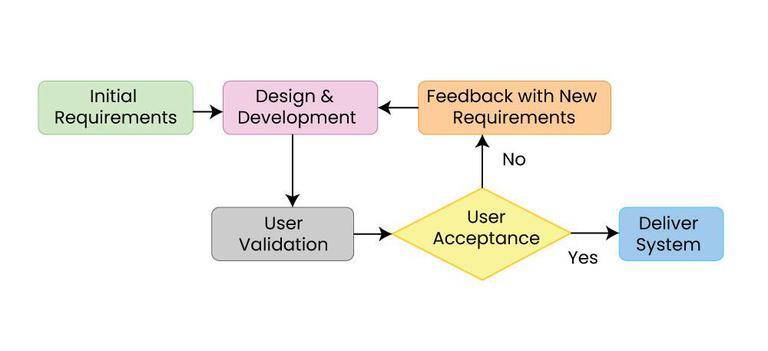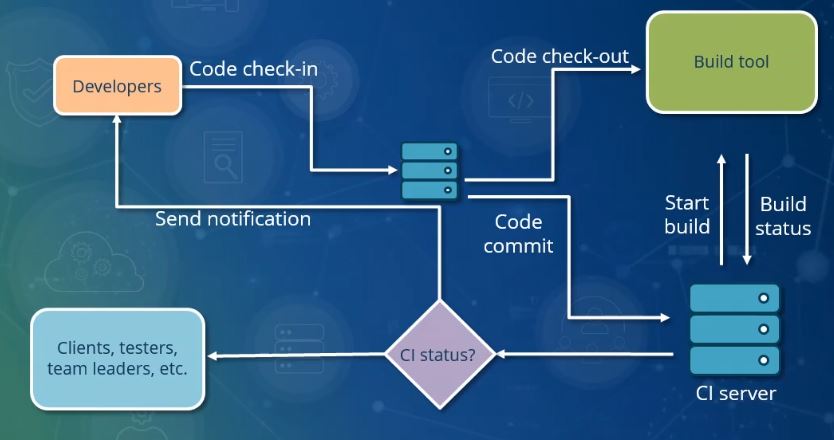|
Multi-stage Continuous Integration
Multi-stage continuous integration is a software development technique intended to achieve highly integrated parallel development activity while reducing the scope of integration problems. Theory Multi-stage continuous integration takes advantage of a basic unifying pattern of software development: software moves in stages from a state of immaturity to a state of maturity, and the work is broken down into logical units performed by interdependent teams that integrate the different parts together over time. What changes from shop to shop is the number of stages, the number and size of teams, and the structure of the team interdependencies. Recommended practices Multi-stage continuous integration is an expansion upon continuous integration, it presumes that you are already following those recommended practices. The larger and/or more complex the project, the higher the chance that the project becomes unstable. Alerts and broken builds increase as the project grows. Progress decrea ... [...More Info...] [...Related Items...] OR: [Wikipedia] [Google] [Baidu] [Amazon] |
Software Development
Software development is the process of designing and Implementation, implementing a software solution to Computer user satisfaction, satisfy a User (computing), user. The process is more encompassing than Computer programming, programming, writing source code, code, in that it includes conceiving the goal, evaluating feasibility, analyzing software requirements, requirements, software design, design, software testing, testing and software release life cycle, release. The process is part of software engineering which also includes management, organizational management, Software project management, project management, configuration management and other aspects. Software development involves many skills and job specializations including software programmer, programming, software test, testing, Technical writing, documentation, graphic design, user support, marketing, and fundraising. Software development involves many software tools, tools including: compiler, integrated develo ... [...More Info...] [...Related Items...] OR: [Wikipedia] [Google] [Baidu] [Amazon] |
Continuous Integration
Continuous integration (CI) is the practice of integrating source code changes frequently and ensuring that the integrated codebase is in a workable state. Typically, developers Merge (version control), merge changes to an Branching (revision control), integration branch, and an automated system Software build, builds and software testing, tests the software system. Often, the automated process runs on each Commit (version control), commit or runs on a schedule such as once a day. Grady Booch first proposed the term CI in Booch method, 1991, although he did not advocate integrating multiple times a day, but later, CI came to include that aspect. History The earliest known work (1989) on continuous integration was the Infuse environment developed by G. E. Kaiser, D. E. Perry, and W. M. Schell. In 1994, Grady Booch used the phrase continuous integration in ''Object-Oriented Analysis and Design with Applications'' (2nd edition) to explain how, when developing using micro ... [...More Info...] [...Related Items...] OR: [Wikipedia] [Google] [Baidu] [Amazon] |
Lean Manufacturing
Lean manufacturing is a methods of production, method of manufacturing goods aimed primarily at reducing times within the Operations management#Production systems, production system as well as response times from suppliers and customers. It is closely related to another concept called just-in-time manufacturing (JIT manufacturing in short). Just-in-time manufacturing tries to match production to Supply and demand, demand by only supplying goods that have been ordered and focus on efficiency, productivity (with a commitment to continuous improvement), and reduction of "wastes" for the producer and supplier of goods. Lean manufacturing adopts the just-in-time approach and additionally focuses on reducing Cycle time variation, cycle, flow, and Throughput (business), throughput times by further eliminating activities that do not add any Value (economics), value for the customer. Lean manufacturing also involves people who work outside of the manufacturing process, such as in marketi ... [...More Info...] [...Related Items...] OR: [Wikipedia] [Google] [Baidu] [Amazon] |
Debugging
In engineering, debugging is the process of finding the Root cause analysis, root cause, workarounds, and possible fixes for bug (engineering), bugs. For software, debugging tactics can involve interactive debugging, control flow analysis, Logfile, log file analysis, monitoring at the application monitoring, application or system monitoring, system level, memory dumps, and profiling (computer programming), profiling. Many Programming language, programming languages and Programming tool, software development tools also offer programs to aid in debugging, known as debuggers. Etymology The term ''bug'', in the sense of defect, dates back at least to 1878 when Thomas Edison wrote "little faults and difficulties" in his inventions as "Bugs". A popular story from the 1940s is from Admiral Grace Hopper. While she was working on a Harvard Mark II, Mark II computer at Harvard University, her associates discovered a moth stuck in a relay that impeded operation and wrote in a log book ... [...More Info...] [...Related Items...] OR: [Wikipedia] [Google] [Baidu] [Amazon] |
Unit Testing
Unit testing, component or module testing, is a form of software testing by which isolated source code is tested to validate expected behavior. Unit testing describes tests that are run at the unit-level to contrast testing at the Integration testing, integration or System testing, system level. History Unit testing, as a principle for testing separately smaller parts of large software systems, dates back to the early days of software engineering. In June 1956 at US Navy's Symposium on Advanced Programming Methods for Digital Computers, H.D. Benington presented the Semi-Automatic Ground Environment, SAGE project. It featured a specification-based approach where the coding phase was followed by "parameter testing" to validate component subprograms against their specification, followed then by an "assembly testing" for parts put together. In 1964, a similar approach is described for the software of the Project Mercury, Mercury project, where individual units developed by dif ... [...More Info...] [...Related Items...] OR: [Wikipedia] [Google] [Baidu] [Amazon] |
AccuRev SCM
AccuRev is a software configuration management application developed by AccuRev, Inc. and was first released in 1999. In December 2013 AccuRev was acquired by Micro Focus. Overview AccuRev is a centralized version control system which uses a client–server model. Communication is performed via TCP/IP using a proprietary protocol. Servers function as team servers, continuous integration servers, or build servers. AccuRev is built around a stream-based architecture in which streams form a hierarchical structure of code changes where parent streams pass on certain properties to child streams. Developers make changes using command line functions, the Java GUI, the web interface, or one of the IDE plug-ins (Eclipse, Visual Studio, IntelliJ IDEA). Characteristics ;Streams and parallel development :AccuRev captures and controls the relationships between code bases in parallel efforts using a stream-based architecture. This allows teams to safely store work and test it before sharing i ... [...More Info...] [...Related Items...] OR: [Wikipedia] [Google] [Baidu] [Amazon] |
Version Control
Version control (also known as revision control, source control, and source code management) is the software engineering practice of controlling, organizing, and tracking different versions in history of computer files; primarily source code text files, but generally any type of file. Version control is a component of software configuration management. A ''version control system'' is a software tool that automates version control. Alternatively, version control is embedded as a feature of some systems such as word processors, spreadsheets, collaborative groupware, web docs, and content management systems, e.g., Help:Page history, Wikipedia's page history. Version control includes viewing old versions and enables Reversion (software development), reverting a file to a previous version. Overview As teams develop software, it is common to Software deployment, deploy multiple versions of the same software, and for different developers to work on one or more different versions ... [...More Info...] [...Related Items...] OR: [Wikipedia] [Google] [Baidu] [Amazon] |
Application Lifecycle Management
Application lifecycle management (ALM) is the product lifecycle management (governance, development, and maintenance) of computer programs. It encompasses requirements management, software architecture, computer programming, software testing, software maintenance, change management, continuous integration, project management, and release management. ALM vs. Software Development Life Cycle ALM is a broader perspective than the Software Development Life Cycle (SDLC), which is limited to the phases of software development such as requirements, design, coding, testing, configuration, project management, and change management. ALM continues after development until the application is no longer used, and may span many SDLCs. Integrated ALM Modern software development processes are not restricted to the discrete ALM/ SDLC steps managed by different teams using multiple tools from different locations. Real-time collaboration, access to the centralized data repository, cross-t ... [...More Info...] [...Related Items...] OR: [Wikipedia] [Google] [Baidu] [Amazon] |
Electric Cloud
Electric Cloud, Inc. was a privately held, DevOps software company based in San Jose, California, United States. Founded in 2002, Electric Cloud was a provider of application release orchestration (ARO) tools, automating release pipelines and managing application life cycles. Electric Cloud's products included ElectricFlow and ElectricAccelerator. In April 2019, CloudBees acquired Electric Cloud and integrated Electric Cloud products into its own portfolio. History Electric Cloud was founded on April 29, 2002, by John Ousterhout, the creator of Tcl, and John Graham-Cumming. In November 2002, Electric Cloud released its first product, ElectricAccelerator. In November 2006, ElectricCommander was released. In June 2014, ElectricCommander became the foundation for the orchestration platform called ElectricFlow. In October 2014, Electric Cloud partnered with author and DevOps specialist Gene Kim to co-found the DevOps Enterprise Summit. The conference focused on agile, continuo ... [...More Info...] [...Related Items...] OR: [Wikipedia] [Google] [Baidu] [Amazon] |
AnthillPro
AnthillPro is a software tool originally developed and released as one of the first continuous integration servers. AnthillPro automates the process of building code into software projects and testing it to verify that project quality has been maintained. Software developers are able to identify bugs and errors earlier by using AnthillPro to track, collate, and test changes in real time to a collectively maintained body of computer code. AnthillPro was released in 2001. In 2006, AnthillPro expanded into an enterprise integration and delivery automation platform supporting continuous integration, deployment automation, application lifecycle management (ALM), and the emerging DevOps methodology. AnthillPro supports distributed and cross-platform builds in .NET, Java, C/C++ and other programming languages. AnthillPro had over 400 enterprise customers worldwide as of 2009. UrbanCode was bought by IBM in April 2013. On August 28, 2017, it was announced that AnthillPro is being retir ... [...More Info...] [...Related Items...] OR: [Wikipedia] [Google] [Baidu] [Amazon] |
Rational Team Concert
Rational Machines is an enterprise founded by Paul Levy and Mike Devlin in 1981 to provide tools to expand the use of modern software engineering practices, particularly explicit modular architecture and iterative development. It changed its name in 1994 to Rational Software, and was sold for US$2.1 billion (equivalent to current US$) to IBM on February 21, 2003. See also * Rational Automation Framework *IBM DevOps Code ClearCase * Rational DOORS * Rational Performance Tester * Rational Rhapsody * Rational Rose * Rational Software Modeler * Rational Synergy *Rational Unified Process The rational unified process (RUP) is an iterative software development process framework created by the Rational Software Corporation, a division of IBM since 2003. RUP is not a single concrete prescriptive process, but rather an adaptable proc ... References External links * {{Authority control Defunct software companies of the United States IBM acquisitions ... [...More Info...] [...Related Items...] OR: [Wikipedia] [Google] [Baidu] [Amazon] |
Agile Software Development
Agile software development is an umbrella term for approaches to software development, developing software that reflect the values and principles agreed upon by ''The Agile Alliance'', a group of 17 software practitioners, in 2001. As documented in their ''Manifesto for Agile Software Development'' the practitioners value: * Individuals and interactions over processes and tools * Working software over comprehensive documentation * Customer collaboration over contract negotiation * Responding to change over following a plan The practitioners cite inspiration from new practices at the time including extreme programming, Scrum (software development), scrum, dynamic systems development method, adaptive software development and being sympathetic to the need for an alternative to documentation driven, heavyweight software development processes. Many software development practices emerged from the agile mindset. These agile-based practices, sometimes called ''Agile'' (with a capital ... [...More Info...] [...Related Items...] OR: [Wikipedia] [Google] [Baidu] [Amazon] |




